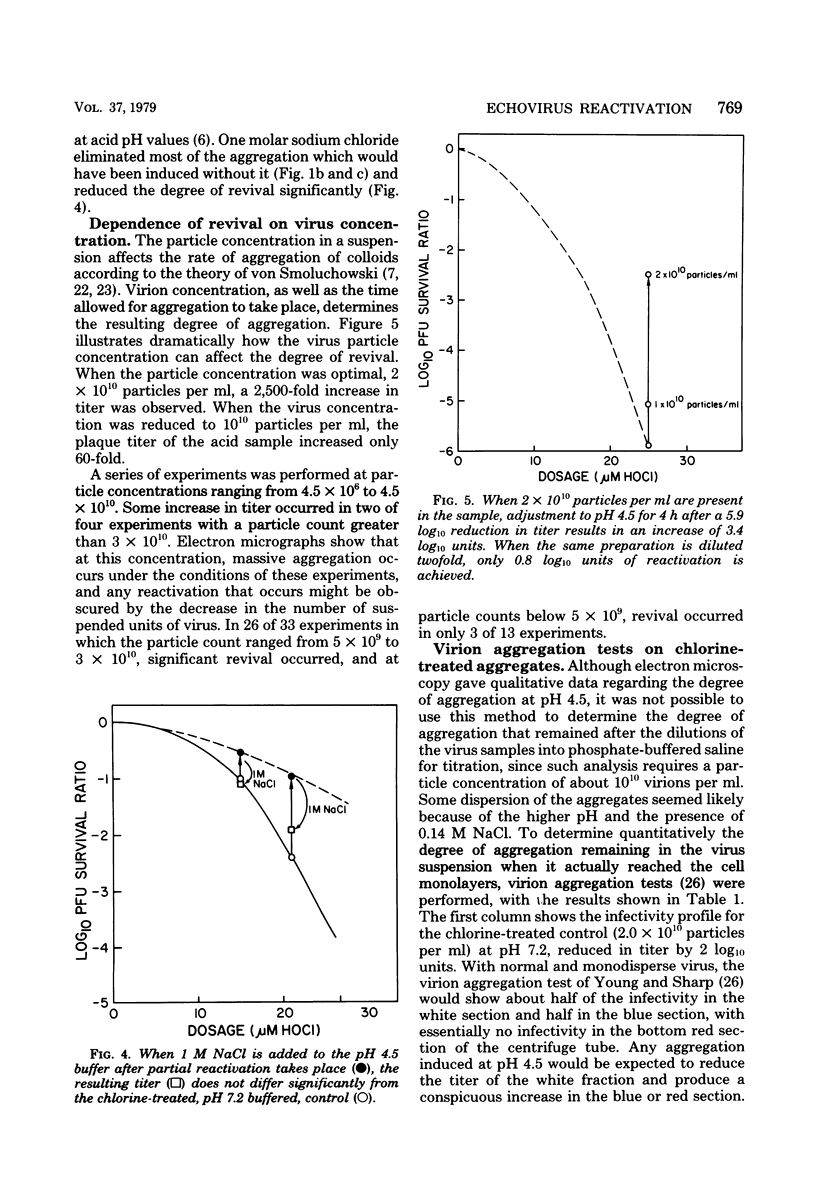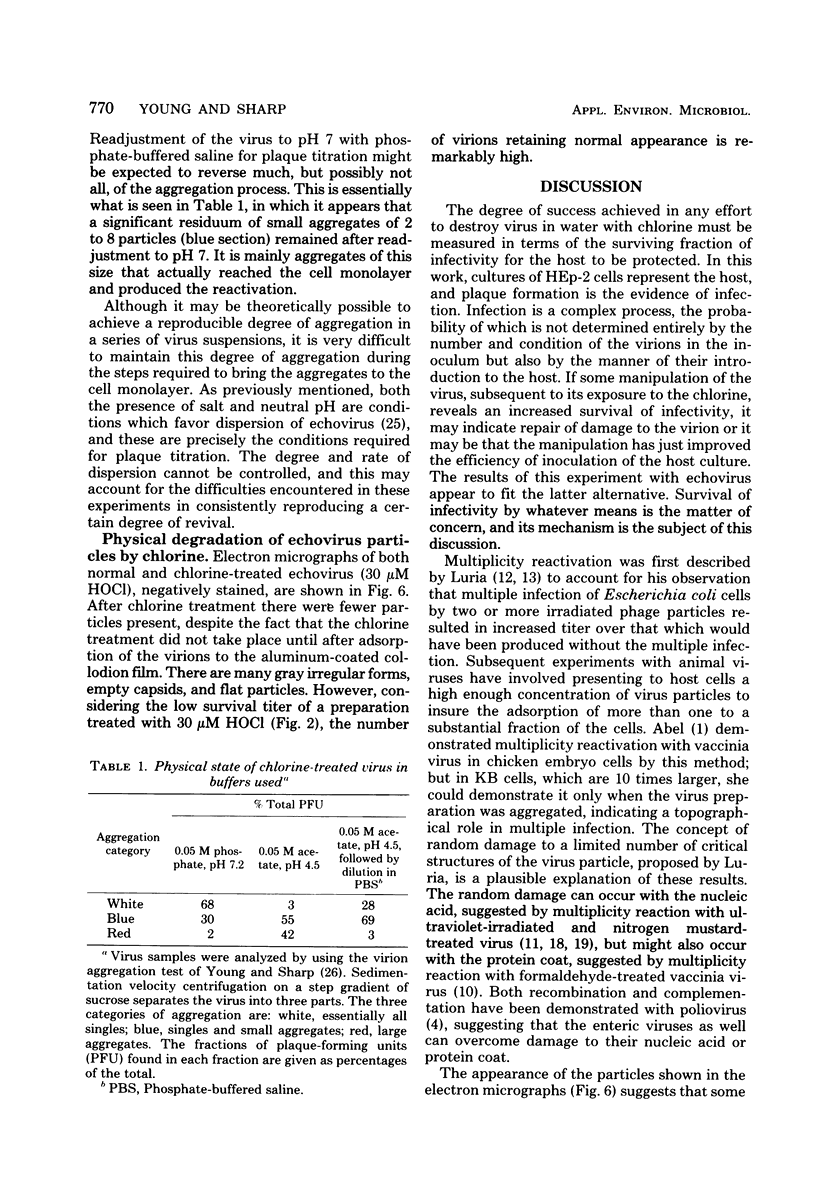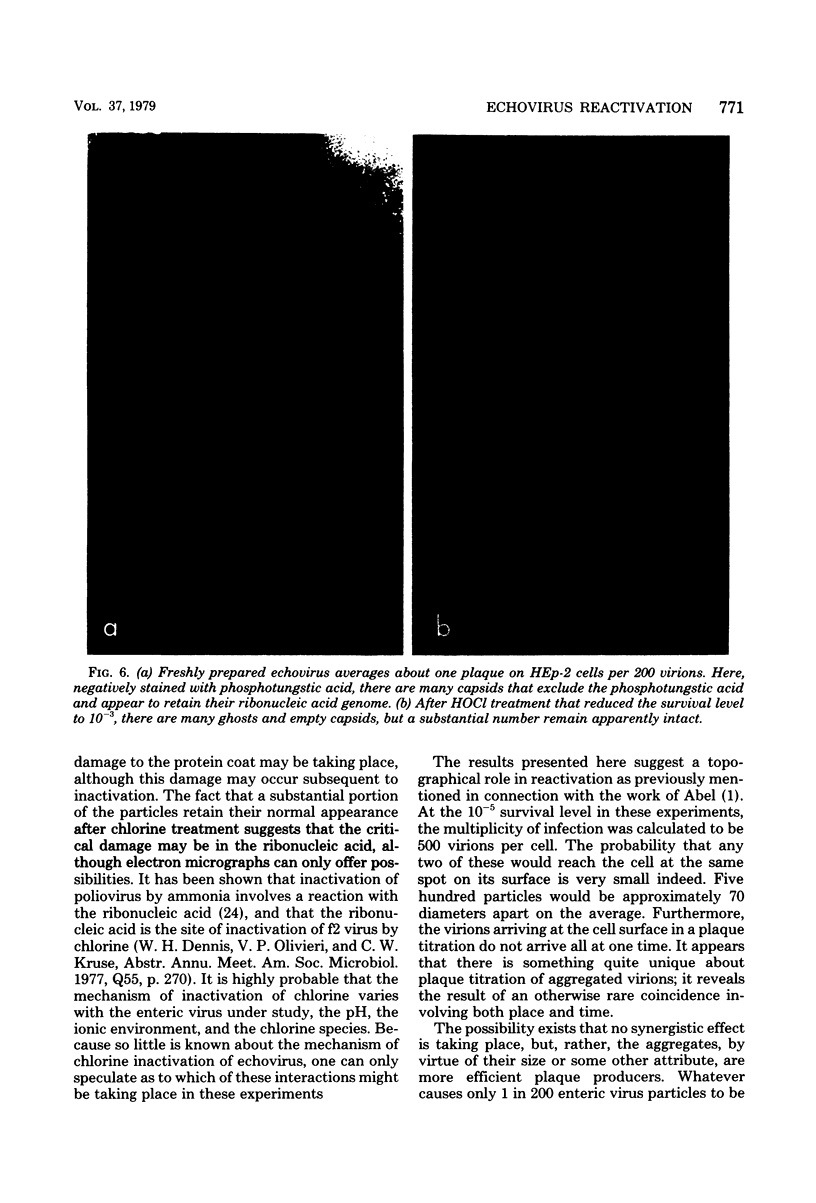Abstract
After treatment of a dispersed suspension of echovirus with HOCl, much of the lost plaque titer was restored if the treated virus was induced to aggregate by adjustment of the suspending medium to pH 4.5. This did not appear to be a repair of individual virions but rather a special kind of multiplicity-related increase in plaquing efficiency which occurred when the host cell received several of the damaged virions in a clump.
Full text
PDF







Images in this article
Selected References
These references are in PubMed. This may not be the complete list of references from this article.
- ABEL P. Multiplicity reactivation and marker rescue with vaccinia virus. Virology. 1962 Aug;17:511–519. doi: 10.1016/0042-6822(62)90150-2. [DOI] [PubMed] [Google Scholar]
- Dalton D., Kim K. S., Sharp D. G. Multiplicity activation of vaccinia virus in L cells. Proc Natl Acad Sci U S A. 1967 Oct;58(4):1758–1761. doi: 10.1073/pnas.58.4.1758. [DOI] [PMC free article] [PubMed] [Google Scholar]
- Floyd R., Johnson J. D., Sharp D. G. Inactivation by bromine of single poliovirus particles in water. Appl Environ Microbiol. 1976 Feb;31(2):298–303. doi: 10.1128/aem.31.2.298-303.1976. [DOI] [PMC free article] [PubMed] [Google Scholar]
- Floyd R., Sharp D. G. Aggregation of poliovirus and reovirus by dilution in water. Appl Environ Microbiol. 1977 Jan;33(1):159–167. doi: 10.1128/aem.33.1.159-167.1977. [DOI] [PMC free article] [PubMed] [Google Scholar]
- Floyd R., Sharp D. G. Viral aggregation: quantitation and kinetics of the aggregation of poliovirus and reovirus. Appl Environ Microbiol. 1978 Jun;35(6):1079–1083. doi: 10.1128/aem.35.6.1079-1083.1978. [DOI] [PMC free article] [PubMed] [Google Scholar]
- Fujioka R. S., Ackermann W. W. Evidence for conformational states of poliovirions: effects of cations on reactivity of poliovirions to guanidine. Proc Soc Exp Biol Med. 1975 Apr;148(4):1070–1074. doi: 10.3181/00379727-148-38690. [DOI] [PubMed] [Google Scholar]
- Fujioka R. S., Ackermann W. W. The inhibitory effects of MgCl2 on the inactivation kinetics of poliovirus by urea. Proc Soc Exp Biol Med. 1975 Apr;148(4):1063–1069. doi: 10.3181/00379727-148-38689. [DOI] [PubMed] [Google Scholar]
- Kim K. S., Sharp D. G. Influence of the physical state of formalinized vaccinia virus particles on surviving plaque titer: evidence for multiplicity reactivation. J Immunol. 1967 Dec;99(6):1221–1225. [PubMed] [Google Scholar]
- Kim K. S., Sharp D. G. Multiplicity reactivation of vaccinia virus particles treated with nitrogen mustard. J Virol. 1967 Feb;1(1):45–49. doi: 10.1128/jvi.1.1.45-49.1967. [DOI] [PMC free article] [PubMed] [Google Scholar]
- Luria S. E., Dulbecco R. Genetic Recombinations Leading to Production of Active Bacteriophage from Ultraviolet Inactivated Bacteriophage Particles. Genetics. 1949 Mar;34(2):93–125. doi: 10.1093/genetics/34.2.93. [DOI] [PMC free article] [PubMed] [Google Scholar]
- Luria S. E. Reactivation of Irradiated Bacteriophage by Transfer of Self-Reproducing Units. Proc Natl Acad Sci U S A. 1947 Sep;33(9):253–264. doi: 10.1073/pnas.33.9.253. [DOI] [PMC free article] [PubMed] [Google Scholar]
- Mandel B. Characterization of type 1 poliovirus by electrophoretic analysis. Virology. 1971 Jun;44(3):554–568. doi: 10.1016/0042-6822(71)90369-2. [DOI] [PubMed] [Google Scholar]
- Sharp D. G., Dunlap R. C. Multiplicity reactivation of vaccinia virus in the cells of the chorioallantoic membrane. Proc Soc Exp Biol Med. 1966 Oct;123(1):111–114. doi: 10.3181/00379727-123-31416. [DOI] [PubMed] [Google Scholar]
- Sharp D. G., Floyd R., Johnson J. D. Initial fast reaction of bromine on reovirus in turbulent flowing water. Appl Environ Microbiol. 1976 Feb;31(2):173–181. doi: 10.1128/aem.31.2.173-181.1976. [DOI] [PMC free article] [PubMed] [Google Scholar]
- Sharp D. G., Floyd R., Johnson J. D. Nature of the surviving plaque-forming unit of reovirus in water containing bromine. Appl Microbiol. 1975 Jan;29(1):94–101. doi: 10.1128/am.29.1.94-101.1975. [DOI] [PMC free article] [PubMed] [Google Scholar]
- Sharp D. G., Kim K. S. Multiplicity reactivation and radiation survival of aggregated vaccinia virus. Calculation of plaque titer based on MR and particle aggregation seen in the electron microscope. Virology. 1966 Jul;29(3):359–366. doi: 10.1016/0042-6822(66)90211-x. [DOI] [PubMed] [Google Scholar]
- Ward R. L. Mechanism of poliovirus inactivation by ammonia. J Virol. 1978 May;26(2):299–305. doi: 10.1128/jvi.26.2.299-305.1978. [DOI] [PMC free article] [PubMed] [Google Scholar]
- Young D. C., Johnson J. D., Sharp D. G. The complex reaction kinetics of ECHO-1 virus with chlorine in water. Proc Soc Exp Biol Med. 1977 Dec;156(3):496–499. doi: 10.3181/00379727-156-39965. [DOI] [PubMed] [Google Scholar]
- Young D. C., Sharp D. G. Poliovirus aggregates and their survival in water. Appl Environ Microbiol. 1977 Jan;33(1):168–177. doi: 10.1128/aem.33.1.168-177.1977. [DOI] [PMC free article] [PubMed] [Google Scholar]




